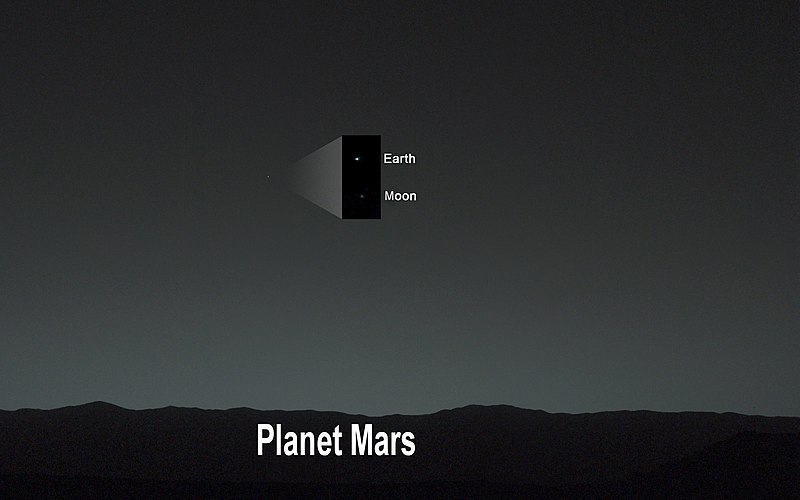Datoteka:PIA17936-f2-MarsCuriosityRover-EarthMoon-20140131.jpg

Vidi sliku u punoj veličini ((3.200 × 2.000 piksela, veličina datoteke: 611 KB, <a href="/wiki/MIME" title="MIME">MIME</a> tip: image/jpeg))
| Ova je datoteka sa stranica Zajedničkog poslužitelja Zaklade Wikimedije i smiju je rabiti drugi projekti. Opis s njezine stranice s opisom datoteke prikazan je ispod. |
Sažetak
| OpisPIA17936-f2-MarsCuriosityRover-EarthMoon-20140131.jpg |
English: PIA17936: Bright 'Evening Star' Seen from Mars is Earth
http://www.jpl.nasa.gov/news/news.php?release=2014-039&1 http://photojournal.jpl.nasa.gov/catalog/PIA17936 http://photojournal.jpl.nasa.gov/jpeg/PIA17936.jpg Figure 1 http://photojournal.jpl.nasa.gov/figures/PIA17936_fig1.jpg Figure 2 http://photojournal.jpl.nasa.gov/figures/PIA17936_fig2.jpg This view of the twilight sky and Martian horizon taken by NASA's Curiosity Mars rover includes Earth as the brightest point of light in the night sky. Earth is a little left of center in the image, and our moon is just below Earth. Two annotated versions of this image are also available in Figures 1 and 2. Researchers used the left eye camera of Curiosity's Mast Camera (Mastcam) to capture this scene about 80 minutes after sunset on the 529th Martian day, or sol, of the rover's work on Mars (Jan. 31, 2014). The image has been processed to remove effects of cosmic rays. A human observer with normal vision, if standing on Mars, could easily see Earth and the moon as two distinct, bright "evening stars." NASA's Jet Propulsion Laboratory, a division of the California Institute of Technology, Pasadena, manages the Mars Science Laboratory Project for NASA's Science Mission Directorate, Washington. JPL designed and built the project's Curiosity rover. Malin Space Science Systems, San Diego, built and operates the rover's Mastcam. More information about Curiosity is online at http://www.nasa.gov/msl and http://mars.jpl.nasa.gov/msl/ Added relevant email message information => From: "NASA Jet Propulsion Laboratory" <jplnewsroom@jpl.nasa.gov> To: <drbogdan@comcast.net> Date: Thu, 06 Feb 2014 19:59:06 -0500 Subject: Curiosity Rover's First Picture of Earth from Mars LATEST NEWS [1][pia17936-226.jpg] [2]Curiosity Rover's First Picture of Earth from Mars The rover's view of its original home planet even includes our moon, just below Earth. [3]Read more References 1. http://www.jpl.nasa.gov/news/news.php?release=2014-039&1 2. http://www.jpl.nasa.gov/news/news.php?release=2014-039&1 3. http://www.jpl.nasa.gov/news/news.php?release=2014-039&1 This message was sent by: NASA's Jet Propulsion Laboratory, 4800 Oak Grove Dr, Pasadena, CA 91109UPLOADER NOTE (05/15/2021): Original NASA image contained "moon" - instead of NASA-approved "Moon" instead (per "Capitalize “Moon” when referring to Earth’s Moon" - from the NASA Style Guide) - to correct this => used an oldie (but goodie) program (PaintShop Pro v6.02) - ( https://en.wikipedia.org/wiki/PaintShop_Pro ) => brushed-out the old "m" on the image after detecting background color with the "dropper" tool - then used the "text" tool (set for "M" using "white" color and "Arial" font) - onto the image - then oriented the new font on the image - saved the new image file - and then uploaded the new image file to Commons as usual - in any case - Stay Safe and Healthy !! - Drbogdan (razgovor) 18:20, 15 May 2021 (UTC) Polski: PIA17936: Jasna 'Wieczorna Gwiazda' widziana z Marsa to Ziemia
http://www.jpl.nasa.gov/news/news.php?release=2014-039&1 http://photojournal.jpl.nasa.gov/catalog/PIA17936 http://photojournal.jpl.nasa.gov/jpeg/PIA17936.jpg Zdjęcie widoku marsjańskiego nieba o zmierzchu wykonane przez należący do NASA łazik Curiosita zawiera Ziemię jako najjaśniejszy punkt światła na nocnym niebie. Ziemia na tym zdjęciu jest nieco na lewo od centrum obrazu, oraz nasz Księżyc jest dokładnie pod Ziemią. Dwa opisane angielskimi adnotacjami zdjęcia są osiągalne poprzez: Naukowcy użyli lewego oka kamery masztowej (Mastcam) łazika Curiosity do zdobycia tej sceny około 80 minut po zachodzie Słońca w 529 marsjańskim dniu, lub w 529 sol, pracy łazika na Marsie, na Ziemi był wtedy 31 stycznia 2014 roku. Zdjęcie to było poddane procesowi usuwania skutków działania promieniowania kosmicznego. Człowiek z normalnym wzrokiem stojący na powierzchni Marsa może zobaczyć bez trudu Ziemię i Księżyc jako dwie wyraźne, jasne "gwiazdy wieczorne". Należący do NASA projekt Mars Science Laboratory używa łazika Curiosity do oszacowania możliwości istnienia w pradawnych dziejach Marsa, możliwości istnienia środowisk będących kolebką życia i głównych zmian jakie w środowisku marsjańskim nastąpiły. Również należący do NASA Jet Propulsion Laboratory, oddział instytutu California Institute of Technology, w Pasadenie, zbudował łazik i kieruje projektem dla należącego do NASA dyrektoriatu Science Mission Directorate w Waszyngtonie. |
| Datum | |
| Izvor | http://photojournal.jpl.nasa.gov/figures/PIA17936_fig2.jpg |
| Autor | NASA/JPL-Caltech/MSSS/TAMU |
Licencija
| Public domainPublic domainfalsefalse |
| This file is in the public domain in the United States because it was solely created by NASA. NASA copyright policy states that "NASA material is not protected by copyright unless noted". (See Template:PD-USGov, NASA copyright policy page or JPL Image Use Policy.) |  | |
 |
Warnings:
|
| Annotations InfoField | This image is annotated: View the annotations at Commons |
Opisi
Predmeti prikazani u ovoj datoteci
motiv
6. veljače 2014
image/jpeg
Povijest datoteke
Kliknite na datum/vrijeme kako biste vidjeli datoteku kakva je tada bila.
| Datum/Vrijeme | Minijatura | Dimenzije | Suradnik | Komentar | |
|---|---|---|---|---|---|
| sadašnja | 15:23, 1. prosinca 2022. |  | 3.200 × 2.000 (611 KB) | Drbogdan | added text - "Planet Mars" - seems better - and clearer |
Poveznice
Na ovu sliku vode poveznice sa sljedećih stranica: